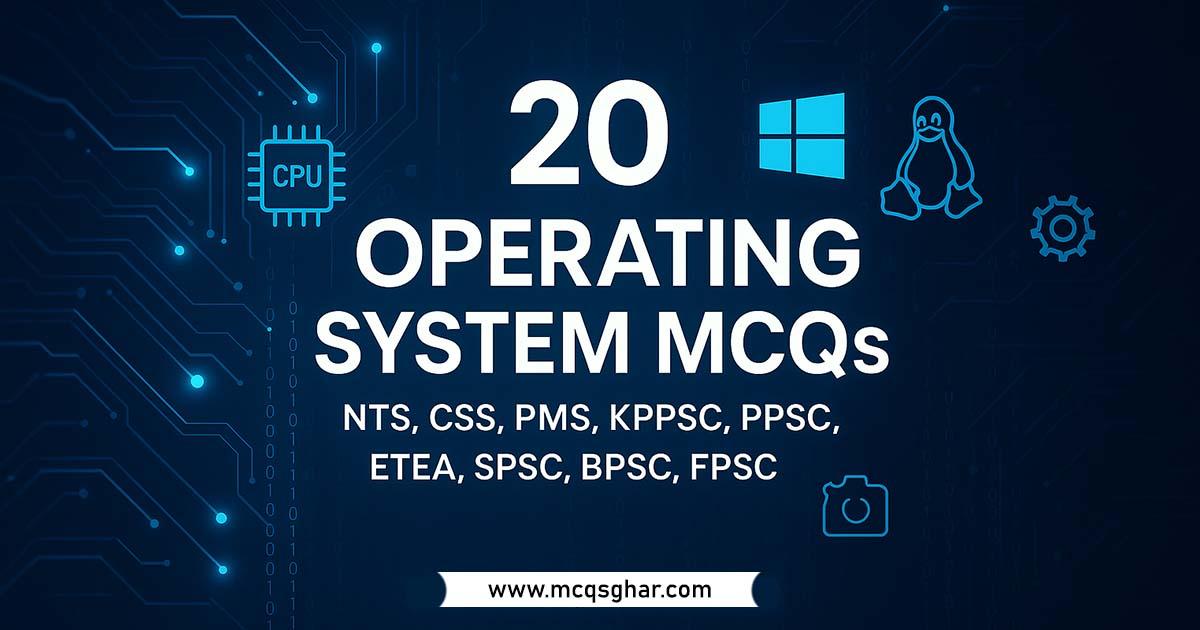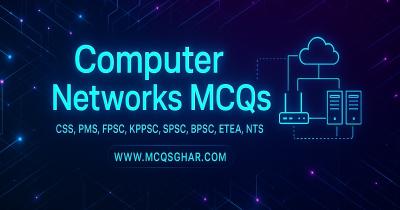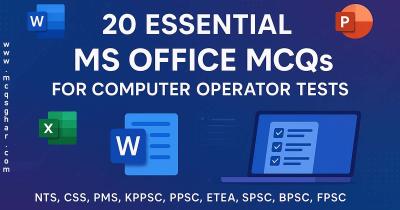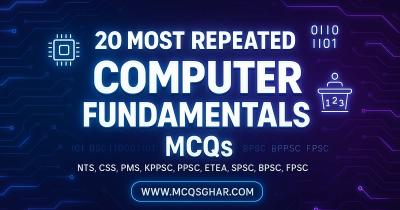بِسْمِ اللَّهِ الرَّحْمَنِ الرَّحِيم
20 Operating System MCQs from NTS, CSS, PMS, KPPSC, PPSC, ETEA, SPSC, BPSC, and FPSC Past Papers
For anyone aiming for higher-grade posts like Computer Science Lecturer, Programmer, or preparing for the NTS, CSS, PMS, KPPSC, PPSC, ETEA, SPSC, BPSC, and FPSC exams, Operating Systems is a fundamental subject you cannot afford to ignore. This topic forms the bedrock of how a computer manages its resources and executes programs. Syllabi for NTS, CSS, PMS, KPPSC, PPSC, ETEA, SPSC, BPSC, and FPSC consistently feature OS concepts as a core component.
The following 20 MCQs have been carefully selected from an analysis of past papers and cover key concepts like process management, scheduling algorithms, deadlocks, and memory management. Each answer includes a technical explanation to solidify your understanding.
Key Operating System Concepts (MCQs)
1. Which of the following is the primary function of an operating system?
- Managing hardware resources
- Providing a user interface
- Executing application programs
- All of the above
Answer: All of the above
Explanation: An operating system has several primary functions. It manages all hardware resources (CPU, memory, disks), provides a user interface (GUI or command line), and creates an environment for application programs to run and access resources.
2. The process of loading the operating system into memory is known as:
- Paging
- Swapping
- Booting
- Interrupting
Answer: Booting
Explanation: Booting is the startup sequence that begins when a computer is turned on. It initializes the system hardware and loads the kernel of the operating system from a storage device (like a hard drive) into the main memory (RAM).
3. A Process Control Block (PCB) does NOT contain which of the following?
- Process State
- Program Counter
- A list of open files
- Bootstrap program
Answer: Bootstrap program
Explanation: A Process Control Block (PCB) is a data structure in the OS kernel that contains all information about a specific process, such as its state (running, waiting), program counter, CPU registers, and open files. The bootstrap program is part of the BIOS/firmware and is responsible for initiating the boot process, not for managing individual processes.
4. Which scheduling algorithm allocates the CPU to the process that has been waiting the longest?
- Shortest Job First (SJF)
- First-Come, First-Served (FCFS)
- Priority Scheduling
- Round Robin
Answer: First-Come, First-Served (FCFS)
Explanation: First-Come, First-Served (FCFS) is a non-preemptive scheduling algorithm that processes jobs in the order they arrive in the ready queue. The process that requests the CPU first is allocated the CPU first.
5. A situation where two or more processes are waiting indefinitely for an event that can only be caused by one of the waiting processes is known as:
- Starvation
- Deadlock
- Aging
- Race Condition
Answer: Deadlock
Explanation: A deadlock is a state in which each member of a group of processes is waiting for some other member to release a resource. The four necessary Coffman conditions for deadlock are Mutual Exclusion, Hold and Wait, No Preemption, and Circular Wait.
6. The memory management technique where a process's physical address space can be non-contiguous is called:
- Paging
- Segmentation
- Contiguous Allocation
- Swapping
Answer: Paging
Explanation: Paging is a memory management scheme that eliminates the need for contiguous allocation of physical memory. It divides physical memory into fixed-sized blocks called frames and logical memory into blocks of the same size called pages.
7. A semaphore is used for:
- Synchronization
- Deadlock avoidance
- Memory management
- File management
Answer: Synchronization
Explanation: A semaphore is a synchronization tool used to manage access to a common resource by multiple processes in a concurrent system. A binary semaphore, for example, can be used to ensure mutual exclusion.
8. Which of the following is a popular open-source, Unix-like operating system?
- Windows
- macOS
- Linux
- DOS
Answer: Linux
Explanation: Linux is a family of open-source operating systems based on the Linux kernel. It is known for its stability, security, and flexibility, and it is used in a wide range of devices from supercomputers to smartphones (Android).
9. What does BIOS stand for?
- Basic Integrated Operating System
- Best Input Output System
- Basic Input Output System
- Binary Input Output Symbol
Answer: Basic Input Output System
Explanation: BIOS stands for Basic Input/Output System. It is firmware stored on a chip on the motherboard that the CPU uses to perform startup procedures when the computer is turned on, including initializing hardware and booting the OS.
10. In the context of operating systems, what is a "shell"?
- The hardware casing of the computer
- A program that provides the user interface
- The core part of the operating system
- A security program
Answer: A program that provides the user interface
Explanation: The shell is a command-line interpreter that provides a user interface for accessing the services of the operating system. Users interact with the shell by typing commands to perform tasks like file management or running programs.
11. The ability of an operating system to run two or more programs simultaneously is called:
- Multitasking
- Multithreading
- Multiprocessing
- Multicomputing
Answer: Multitasking
Explanation: Multitasking allows a user to perform more than one computer task at a time. The operating system manages the switching between these tasks so rapidly that it appears they are all running at the same time.
12. Virtual memory is a technique that:
- Makes the RAM appear larger than it is
- Makes the hard drive faster
- Allows multiple operating systems to run
- Is a form of RAM
Answer: Makes the RAM appear larger than it is
Explanation: Virtual memory is a memory management technique that provides an "illusion" of a very large main memory. It works by moving data between RAM and disk storage, allowing the system to run larger programs or more programs concurrently than the physical RAM would allow.
13. Which file system is primarily used by modern versions of Windows?
- FAT32
- EXT4
- HFS+
- NTFS
Answer: NTFS (New Technology File System)
Explanation: NTFS (New Technology File System) is the standard file system for Windows NT and its descendants (Windows 2000, XP, Vista, 7, 8, 10, 11). It offers improvements over the older FAT file system, including better performance, security, and larger file sizes.
14. A small piece of code that is used to locate and load the main operating system is the:
- Kernel
- Bootstrap loader
- Shell
- System call
Answer: Bootstrap loader
Explanation: The bootstrap loader, or bootloader, is a small program stored in the BIOS/UEFI firmware. Its primary job is to load the kernel of the operating system from the hard drive into RAM so that the OS can start running.
15. Which of the following is NOT a condition for deadlock?
- Mutual Exclusion
- Hold and Wait
- Preemption
- Circular Wait
Answer: Preemption
Explanation: The four necessary conditions for deadlock are Mutual Exclusion, Hold and Wait, No Preemption, and Circular Wait. Preemption (taking a resource away from a process) is a method to prevent or resolve deadlocks, not a condition that causes them.
16. The "time slice" in a Round Robin scheduling algorithm refers to:
- The total time a process takes to execute
- The time a process has been waiting in the queue
- The maximum time a process can run before being preempted
- The time it takes to switch between processes
Answer: The maximum time a process can run before being preempted
Explanation: Round Robin is a preemptive scheduling algorithm where each process is assigned a fixed time slice (or quantum). A process runs for this duration, and if it's not finished, it is preempted and moved to the back of the ready queue.
17. An operating system acts as a(n) __________ between the user and the computer hardware.
- Intermediary
- Compiler
- Translator
- Server
Answer: Intermediary
Explanation: The operating system serves as an intermediary, managing the complex interactions between the user's applications and the physical hardware. It abstracts the hardware's complexity, providing a simpler and more consistent interface for software to use.
18. Which of the following is a real-time operating system (RTOS)?
- Windows 10
- Android
- VxWorks
- Ubuntu
Answer: VxWorks
Explanation: A Real-Time Operating System (RTOS) is designed for systems that require a very fast and predictable response to events, such as in industrial control or robotics. VxWorks is a widely used commercial RTOS. General-purpose operating systems like Windows or Ubuntu are not typically real-time.
19. The concept of a process having multiple, concurrent paths of execution is known as:
- Multitasking
- Multithreading
- Multiprogramming
- Multi-access
Answer: Multithreading
Explanation: Multithreading is a feature that allows a single process to have multiple threads of execution. These threads share the process's resources but can run independently, improving the efficiency and responsiveness of the program.
20. On-line real-time systems became popular in which generation of computers?
- First Generation
- Second Generation
- Third Generation
- Fourth Generation
Answer: Third Generation
Explanation: Third-generation computers (1965-1971), which used Integrated Circuits (ICs), saw the rise of more advanced operating systems that supported features like multiprogramming and time-sharing, enabling on-line real-time systems.




